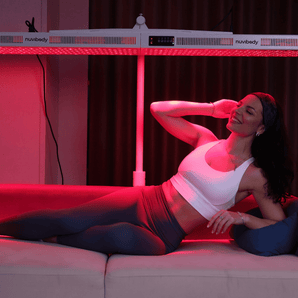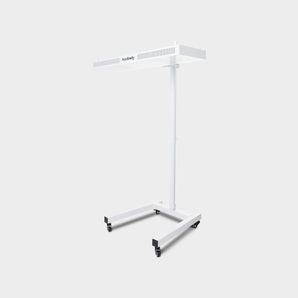Have you ever wished your skin felt firmer and more youthful, without invasive treatments? Then this article is for you. Red light therapy, a natural way to stimulate collagen production, is quickly gaining popularity due to its effectiveness and simplicity. In this blog, you will discover how red light therapy can help reduce wrinkles and improve your skin, all from the comfort of your own home.
Table of contents
|
Introduction
Collagen is the most abundant protein in the human body and plays a vital role in the structure and elasticity of the skin. It forms the basis of connective tissue and supports not only the skin, but also the bones, muscles, tendons and ligaments. In the context of skin health, collagen provides firmness, plumpness and a youthful appearance. As we age, the natural production of collagen decreases, leading to signs of aging such as wrinkles, fine lines and sagging skin.
Red light therapy, also known as low-level laser therapy (LLLT) or photobiomodulation (PBM), uses low wavelengths of red to near-infrared light to treat a variety of skin concerns, including improving skin texture and increasing collagen production. This therapy is praised for its non-invasive nature and minimal side effects, making it an attractive option for those looking for an effective way to improve the health and appearance of their skin. Red light therapy works by stimulating mitochondrial function in cells, leading to increased energy production and promoting healing and regeneration processes, including collagen synthesis.
What is Red Light Therapy?
Red light therapy, known as photobiomodulation (PBM) or low-level laser therapy (LLLT), is on the cusp of a revolutionary breakthrough in the world of skin care and regenerative medicine. This fascinating treatment method uses specific wavelengths of light from red to near-infrared to penetrate deep into the skin’s layers, where it promotes natural healing processes and cell regeneration. But what makes red light therapy so special, and how has it become one of the most talked about topics in the aesthetic and medical communities?
A Dive into History
The discovery and development of red light therapy can be traced back to the 1980s, when NASA experiments using light therapy to promote plant growth in space accidentally revealed the potential of red light for cell growth and repair in humans. Since then, numerous scientific studies and clinical trials have highlighted the wide range of health benefits this therapy offers, from wound healing and pain relief to anti-aging effects and skin rejuvenation.
How Does Red Light Therapy Work?
The key to the effectiveness of red light therapy lies in its ability to stimulate the mitochondria in our cells - the so-called powerhouses of the cell. By increasing the activity of mitochondria, it promotes the production of adenosine triphosphate (ATP), which is essential for energy transfer and supporting almost all cellular processes, including cell growth and repair.
When exposed to red light, skin cells respond by increasing their metabolism, increasing collagen and elastin production, and improving the elimination of toxins. This process not only helps repair damaged cells, but also promotes the formation of new cells, resulting in healthier, firmer, and more youthful-looking skin.

Differences with Other Light Therapies
Unlike UV light, which can be damaging to the skin, red light offers a safe, non-invasive treatment option without the risks of exposure to harmful rays. Red light therapy should not be confused with blue light therapy, which is primarily used to treat acne due to its antibacterial properties. Red light focuses on skin repair and rejuvenation, while blue light focuses on eliminating bacteria.
Scientific Evidence and Effectiveness
The scientific community has studied red light therapy extensively, with studies showing its effectiveness in improving skin health, reducing inflammation, and accelerating healing. These studies support the claims that red light therapy can be a powerful tool in the fight against skin aging, repairing skin damage, and improving overall skin texture and appearance.
Due to its impressive range of benefits and its ability to support the body's natural healing processes, red light therapy has firmly established itself as a valuable addition to modern skin care and health regimes, making it a must-have treatment for anyone striving for healthy, radiant skin.
The Role of Collagen in the Skin
Collagen is at the center of the discussion about skin health and rejuvenation, and rightly so. This crucial protein, the most abundant in our bodies, is key to maintaining the firmness, elasticity, and overall youthful appearance of our skin. However, collagen’s role in the skin goes beyond the merely aesthetic, as it performs fundamental functions that are essential to both the integrity and health of our skin.
Functions and Benefits of Collagen for Skin
Collagen acts as the building block of the skin, providing a supporting structure that helps keep the skin firm and resilient. This protein is responsible for maintaining skin elasticity, allowing our skin to regain its shape after being stretched or compressed. Furthermore, collagen plays a vital role in the skin’s hydration process, as it helps retain moisture, which is essential for hydrated, smooth, and radiant skin.

Causes of Decreased Collagen Production with Age
As we age, our skin begins to lose its ability to produce and regenerate collagen at the same rate. This natural aging process is exacerbated by external factors such as UV exposure, pollution, smoking, and unhealthy eating habits, all of which contribute to the breakdown of collagen fibers. The result is a visible decrease in skin elasticity and firmness, leading to the formation of wrinkles, fine lines, and other signs of aging.
The Impact of Decreased Collagen on Skin Health and Appearance
Loss of collagen not only affects the appearance of our skin, but also affects the overall health of the skin. Thinning skin, dryness, and increased vulnerability to injury are some of the direct consequences of decreased collagen. In addition, the skin loses its ability to function effectively as a barrier against external damaging agents, which can lead to increased susceptibility to allergies, infections, and skin diseases.
The crucial role of collagen in the skin highlights the importance of supporting collagen production through both internal and external approaches, including a balanced diet rich in collagen-boosting nutrients, avoiding harmful habits like smoking, and using skin care treatments like red light therapy . By taking active steps to boost collagen production and minimize its breakdown, we can effectively combat the signs of aging and improve the overall health and appearance of our skin.
How Red Light Therapy Helps Boost Collagen
Red light therapy is a scientifically proven treatment that is revolutionizing the way we think about skin care and rejuvenation. By utilizing specific wavelengths of red and near-infrared light, it offers a powerful, non-invasive method of stimulating the skin’s natural production of collagen. This section dives deeper into the science behind red light therapy and how it promotes collagen synthesis, an essential factor for healthy, youthful skin.
Scientific Basis: Stimulation of Collagen Synthesis
The effectiveness of red light therapy in stimulating collagen production is rooted in its ability to penetrate deep into the skin layers and initiate photobiomodulation processes. These processes lead to increased activity of fibroblasts, the cells responsible for collagen production. Under the influence of red light, fibroblasts increase their collagen synthesis, resulting in an improvement in skin structure and elasticity. This effect is crucial for reducing the signs of skin aging, such as wrinkles and fine lines, and for promoting skin regeneration.

Differences between Red Light and other Light Therapies
Unlike UV light, which can damage the skin, and blue light, which is mainly used to treat acne, red light has a unique position due to its ability to rejuvenate the skin without damage. Red light therapy works on a deeper level, directly affecting the cellular mechanisms responsible for the health and appearance of the skin. This property distinguishes it as a treatment of choice for anyone looking for a safe way to rejuvenate the skin and increase collagen production.
Research into the Effectiveness of Red Light Therapy
A growing number of scientific studies and clinical trials have confirmed the positive effects of red light therapy on the skin. These studies consistently show that regular treatment with red light can lead to significant improvements in skin texture, elasticity, and overall appearance. Importantly, these studies have also documented increased collagen in the treated areas, supporting the claims that red light therapy is an effective method for stimulating skin rejuvenation at the cellular level.
Benefits of Red Light Therapy for Skin Rejuvenation
Red light therapy, with its unique ability to penetrate the deeper layers of the skin without causing damage, offers an impressive list of benefits that go beyond skin rejuvenation. This treatment, beloved by dermatologists and skin care enthusiasts, promises to not only reduce the outward signs of aging, but also supports the overall health and vitality of the skin. Let’s explore some of the most notable benefits of red light therapy for skin rejuvenation.
Reduction of Wrinkles and Fine Lines
One of the most valued effects of red light therapy is its ability to reduce the appearance of wrinkles and fine lines. By stimulating the production of collagen and elastin, it helps the skin regain its firmness and elasticity, making wrinkles less visible. This results in a smoother, more refined skin texture and a more youthful appearance.

red light therapy against wrinkles and fine lines
Improvement of Skin Texture and Elasticity
Red light therapy not only promotes collagen production, but also stimulates skin renewal and improves blood circulation. These processes work together to improve skin texture and increase elasticity, leaving skin feeling firmer and more resilient. Users often notice an improvement in the overall tone and texture of their skin, with a reduced appearance of pores and a more even-toned complexion.
Reduction of Scars and Hyperpigmentation
In addition to its anti-aging effects, red light therapy also has positive effects on the reduction of scars, including acne scars, and hyperpigmentation. By promoting the skin's natural healing process and stimulating the production of new tissue, red light therapy can help reduce the appearance of scars and give the skin a more uniform color.

red light therapy for acne scars
Overall Improvement of Skin Health
Red light therapy offers wide-ranging benefits for skin health due to its anti-inflammatory properties and ability to improve skin barrier function. It can help reduce redness, swelling, and irritation, making it an excellent treatment option for conditions such as rosacea, eczema, and psoriasis. Additionally, the increased blood circulation and oxygen supply to skin cells can contribute to healthier, more radiant skin.
Practical Application of Red Light Therapy
The practical application of red light therapy in the context of skin rejuvenation and overall skin health offers a wide range of possibilities for both at-home and professional treatments. Known for its simple, safe, and effective approach, this therapy has changed the way individuals approach their skin care goals. Below is a detailed look at the practical aspects of red light therapy, including what a typical session looks like, the differences between at-home and professional treatments, and safety considerations.
What a Red Light Therapy Session Looks Like
A typical red light therapy session can vary depending on the specific equipment and settings used, but in general the process involves exposing the target area of the skin to red light for a set period of time, usually between 5 and 15 minutes per day. Users can choose to focus on specific areas, such as the face for anti-aging effects, or on larger parts of the body for muscle recovery and reduced inflammation.

Home Use vs. Professional Treatments
-
Home Use: The increased availability of equipment and light panels has made red light therapy both more affordable and accessible for home use. These devices are specifically designed to be simple and safe to use, making it easy to incorporate the therapy into your daily skin care routine. However, with this increased accessibility, many inferior devices have also entered the market. For advice on purchasing a quality red light therapy lamp, please refer to our red light therapy buying guide .
-
Professional Treatments: In a clinical or spa setting, red light therapy sessions are often combined with other skin care treatments for maximum results. Professional treatments can be particularly helpful for those seeking a more concentrated or intensive therapy for specific skin conditions.
Combining Red Light Therapy with Other Skin Care Routines
- Red light therapy can be a powerful addition to your existing skincare routine. Using products that nourish and protect the skin, such as those with antioxidants, hyaluronic acid, and peptides, can enhance the effects of the therapy by providing the skin with additional support for repair and rejuvenation.
- However, it is important to avoid applying strong exfoliants or potential irritants immediately before or after your red light therapy session, as the skin may be more sensitive.
Safety and Possible Side Effects
Red light therapy is generally considered safe, with minimal side effects. It is non-invasive, painless, and requires no recovery time, making it an attractive option for a wide range of users. Some possible side effects may include redness or irritation of the skin, but these are usually temporary and mild. However, it is important to follow the instructions in the label and not overuse the therapy, as excessive exposure can negate the effects.
Conclusion
By increasing collagen production, red light therapy helps promote firmer, smoother, and more youthful-looking skin, while also helping to reduce inflammation, improve skin texture, and promote overall skin repair.
The effectiveness of red light therapy, supported by scientific research and clinical studies, makes it a valuable addition to modern skin care strategies. Whether used at home or in professional settings, red light therapy offers an accessible option for individuals looking to enhance their skin care routine without resorting to invasive procedures. With proper care and attention, red light therapy can be a valuable and effective addition to any skin care routine, helping to promote healthier, more youthful-looking skin.
Sources
1. The Efficacy of Red Light Treatment in for reduction of Fine Lines, Wrinkles, Skin Roughness, and Intradermal Collagen Density Increase:
https://www.ncbi.nlm.nih.gov/pmc/articles/PMC3926176/
2. Reverse skin aging with red light therapy: https://pubmed.ncbi.nlm.nih.gov/37522497/
Frequently Asked Questions
What is red light therapy and how does it work to boost collagen?
Red light therapy, also known as photobiomodulation, uses specific wavelengths of light to penetrate deep into the skin’s layers, where it stimulates cellular activity. This stimulation promotes the production of collagen, an essential protein that gives skin its firmness and elasticity, reducing signs of aging such as wrinkles and fine lines.
How often should I use red light therapy for best results?
Frequency can vary depending on the specific device and your personal skincare needs, but in general it is recommended to use the therapy at least 2-3 times per week. Some people may benefit from daily use, while others see sufficient results with less frequent sessions.
Is red light therapy safe for all skin types?
Yes, red light therapy is considered safe for all skin types. It does not cause UV damage to the skin and is a non-invasive treatment, meaning it has a low chance of side effects. As with any skincare treatment, it is advisable to consult a dermatologist first, especially if you have sensitive skin or specific skin concerns.
Can I do red light therapy at home?
Yes, there are many home devices available that offer red light therapy. These range from handheld devices to larger light panels. It is important to choose a device from a reputable manufacturer and follow the instructions carefully to get the best results. Nuvibody devices are some of the most powerful on the market and have undergone 3rd party testing to ensure safety.
What are the main benefits of red light therapy besides boosting collagen?
In addition to increasing collagen production, red light therapy can help reduce inflammation, improve skin texture, reduce scarring and hyperpigmentation, and support the skin’s healing process. It also has benefits for relieving muscle pain and promoting overall health.
Are there any side effects associated with using red light therapy?
Side effects of red light therapy are rare and usually mild. Some users experience temporary redness or irritation in the treated areas, but these symptoms usually disappear quickly. It is essential not to overuse the device or exceed the recommended exposure times. If you are taking medications that can cause phototoxic reactions or have cancer, consult a medical professional before beginning red light therapy.
How long does it take before I see results from red light therapy?
The time to see results can vary from person to person, depending on factors such as age, skin type, and consistency of use. Some people notice improvements within weeks, while for others it can take months. Consistency and patience are key to achieving the best results.


















